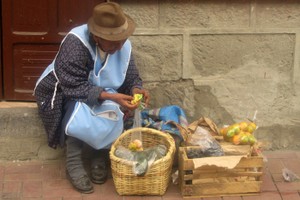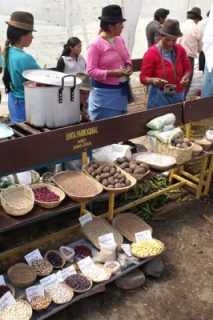This article looks at a system designed and implemented by members of an indigenous community in central Ecuador, which, by localising food production, distribution and consumption, ties together a series of efforts that provide a safeguard against the precarious nature of local employment and fluctuating food prices. Results so far show that this collective action is strengthening community cohesion, and demonstrate how initiatives based on the concept of food sovereignty can address some of the clear inequalities of our globalised food system.

We need to consider both (and differentiate between) a lack of food and a lack of power. This is especially relevant when looking at the role and possibilities of small-scale farmers, the largest group of food producers, in making their own choices about what crops to grow and where those crops go. In short, over their access to food.
The comuna and the circle
A recent initiative in Ecuador addresses these issues, and has given rise to weekly exchanges of food in the village square of San Isidro. Located in the province of Cotopaxi, San Isidro is a “comuna”, or a community of 500 persons (84 families) in Ecuador’s central Andes. The plan to support producers and consumers was born out of discussions that took place among friends, supporters and staff of a local education organisation which regularly hosts youth workshops, village-council meetings, seminars and language classes. The idea of a village-based food exchange system quickly attracted participants keen to create an alternative outlet for their home-grown products, and interested in having a greater degree of control over where they end up.

Farmers in San Isidro grow a variety of traditional and staple crops on small plots, all of which are rain-fed or watered with the comuna’s own irrigation system. These include a number of beans and kidney beans, together with staples such as habas (broad beans) and maize. These are sold and exchanged in the local and regional markets, and nowadays through the Food Circle itself, together with potatoes, onions, beetroot, lettuce, carrots, and fruits such as mora (or blackberries). While a wide variety of potatoes are grown and traded, there are fewer people growing other Andean tubers such as ocas (Oxalis tuberosa) or mashua (Tropaeolum tuberosum). So, the Food Circle encourages participants to cultivate these crops, increasing their availability and visibility in the area. Some families are also cultivating kinwa (quinoa) and amaranth and share the grains with their neighbours.
The range and quantity of products available for exchange every week varies according to changing weather conditions, crop cycles and labour patterns. Detailed planning and co-operation is needed among participants in order to meet their food requirements in the best way. Currently, a production schedule with an emphasis on neglected or under-cultivated crops, and on the region’s traditional crops, is being formulated. It aims to be flexible enough to absorb quantity variations yet broad enough to ensure that the requirements of consumers are met. This is helped by an overlap between the farmers and consumers within the Circle.
Collective safeguards
Policies, sovereignty and agro-ecology
San Isidro’s Food Circle is one of many efforts to modify food systems in Ecuador. These initiatives are occurring in a political environment that, at least notionally, supports the idea of food sovereignty. Ecuador’s 2008 Constitution specifies that “a strategic obligation of the State” is “to guarantee its people self sufficiency in food that is healthy and culturally appropriate, in a permanent form”. The same document further specifies the state’s responsibilities, which include the promotion of redistributive policies to permit farmers access to land, water and other productive resources; the preservation and rehabilitation of the country’s agro-biodiversity; the generation of just and equitable systems for distributing and commercialising food, and also to “impede monopolistic practices and any type of speculation with food products”.
The country’s legislation does not officially recognise an agro-ecological approach to production. Yet, while agro-ecology and food sovereignty can be seen as “separate concerns”, the majority of those involved in advocacy groups around each issue, and the majority of producers and rural citizens, see these issues as two sides of the same coin. Questions about what crops are grown and in what quantities are directly related to those about how those crops are grown. If there is a gap between these issues in governmental policies, the two issues are becoming increasingly intertwined in rural areas, where “theories” are continually being developed, tried out and reformed in the field. Visitors to San Isidro can see a large poster hanging in the communal meeting hall, proudly stating that “San Isidro is an Agroecological Community”.
The Food Circle is the first commercialisation programme to be tried in San Isidro. There have been previous projects in the region, such as those set up with the guidance of organisations like MICC (Movimiento Indigena y Campesino de Cotopaxi), which encouraged the cultivation of certain crops (such as quinoa) or addressed the unequal concentration of productive resources in the province (such as water, which largely remains in the hands of large agribusiness units). But the Food Circle is unique in the way it supports small-scale agriculture and focus on the availability of, and access to, food.
But while the Food Circle focuses on retaining or regaining control over food production and consumption, all the villagers experience economic realities which are in marked contrast to these efforts. Many of the men in the village travel away to work in the oil fields in the Amazon region – while their families cultivate plots of land in the village to which they return after a few months. These migrating villagers recognise an increasing level in the “precariousness” of their jobs, having only temporary contracts, with many not being renewed – for no apparent reason.
The Food Circle is not large enough, nor strong enough, to provide families with a sufficient income. But it does secure their access to affordable food, and ensures that the land in the village continues to be cultivated.
The Food Circle offers a more dependable market for the small amount of produce being grown (in comparison with the regional markets, attended by both producers and merchants), resulting not only in a source of income, but also providing an opportunity to directly negotiate the purchase-price of staple crops. These advantages can be seen as part of the “collective safeguards” which effectively protect the rural areas against uncertainty.
Aiming higher
Increasing the diversity of crops on a farm can have many positive consequences: it can improve the fertility of the soil and increase a farm’s resilience against adverse weather conditions (avoiding the shortcomings of “conventional” cropping systems). These benefits are experienced directly by the participants of the Food Circle. Even though reducing the consumption of some non-local foodstuffs is not an explicit objective of the Food Circle, crops that once were in danger of being forgotten or abandoned are once again being grown, exchanged and enjoyed, and participants are benefitting from a more diverse diet.
The Food Circle complements existing efforts to collectively manage the region’s natural resources, and further promotes the principles of small-scale and agro-ecological agriculture. By encouraging local production systems, securing local incomes and maximising the level of community and producer control over food prices and destinations, participants safeguard their access to food. The Food Circle is thus an interesting model for a national food sovereignty programme.
Text: Tristan Partridge
Tristan Partridge works at the University of Edinburgh, U.K., and also as a researcher with FLACSO Quito, Ecuador.
